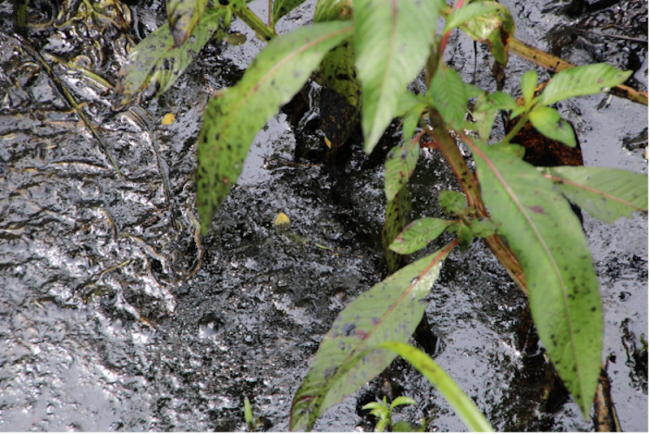
Between the 1930 and 1960s, subregions of the Magdalena Medio in Colombia’s Antioquia and Bolivar departments were known as “Shell’s paradise.” I quickly learned why when I visited the region in March and April of 2023 to assess air, water, and soil contamination as part of a multi-country assessment of oil and gas impacts in South America for the nonprofit advocacy organization Earthworks. (Some of this material was published in a series for NACLA).
This inter-Andean valley surrounding the Magdalena River in central Colombia is rich in forests, waters, flora, fauna, fertile soil—and oil and minerals. It is also a major sociocultural, environmental, and economic lifeline and waterway for the country. Multinational companies have long and intensively explored for oil in the valley, although the terrain was quite inhospitable and labor conditions were brutal. By the 1960s, the state-owned company Ecopetrol had come to dominate the hydrocarbon industry in the region, although a few foreign corporations were still awarded exploration rights.
Soon, the region could become known as “Ecopetrol’s nightmare.” When I first arrived at the Magdalena Medio, I did not know this research would reveal alarming findings, leading to a whistleblower report, a BBC documentary, and a comprehensive report on serious alleged environmental violations and risks posed to nearby communities by Ecopetrol authorities.
After a two-year investigation, the comprehensive report and exposé, Crude Lies, was published last week by the Environmental Investigation Agency in collaboration with Earthworks. It was released alongside the whistle-blower Iguana Papers, a trove of internal Ecopetrol files showing alleged efforts to hide pollution and surveil and coerce impacted community members. The files were shared by Andrés Olarte Peña, a petroleum engineer who worked at Ecopetrol from 2017 to 2019 as an analyst and environmental advisor under the supervision of the then-CEO of Ecopetrol, Felipe Bayón, and the vice-president of sustainability, Eduardo Uribe. With access to high-level data and operations from the company, Olarte Peña realized that the company was seriously harming local communities. Today, he is living in exile, and he and his family have received death threats.
The findings in the report and files suggest serious violations of Colombian environmental law by Ecopetrol authorities between 2014 and 2018, as well as ongoing human rights and environmental concerns. The alarming details of the report are outlined in a documentary produced by the BBC World Service. Taken together, these materials suggest that Ecopetrol not only knowingly caused harm and contamination, but also poses a significant challenge to Colombia’s ambitious climate policies and its image as a regional leader in environmental action.
Given the history of heavy exploration in regions like Magdalena Medio, tense circumstances involving Colombia’s oil and gas sector should come as no surprise. Nevertheless, the findings should serve as a harsh rallying cry for environmental advocates everywhere. The pollution I documented, the Crude Lies report and accompanying materials, and the stories partners have shared in Magdalena Medio help to illustrate why Colombia and its shareholders must divest from extraction and forge a more just energy future for the nation. Colombia’s current president, Gustavo Petro, has positioned himself as the leader of Colombia’s energy transition and made strong vows to halt oil and gas extraction contracts. More recently, however, he has relented on some of these promises, as evidenced by new exploratory operations in Colombia’s Caribbean offshore waters.
The Proximity of Pollution
As a certified thermographer from Earthworks, I used an optical gas imaging (OGI) camera to record severe forms of air contamination not visible to the naked eye—particularly methane and volatile organic compounds like benzene, toluene, butane, propane, and 15 other gasses. We filmed air contamination principally at gas and oil operations operated by Ecopetrol and the Chinese-Indian company Mansarovar Energy.
The findings, seen through a FLIR GF320 OGI camera, include evidence of what appears to be routine venting and incomplete burning of greenhouse gas emissions, as well as unintended fugitive emissions in oil and gas infrastructure in Yondó, Puerto Boyacá, Barrancabermeja, and Puerto Wilches. The release of gasses near communities, waterways, and marshes puts much of the population and ecosystem at risk of serious health and climate harms.
At a facility operated by Mansarovar Energy (Bateria #3) in Campo Velásquez, Puerto Boyacá, the OGI camera revealed emissions being released from a seemingly open hatch atop the black oil tank, which cannot be seen with the naked eye. The tank battery and two adjacent gas wells (not depicted here) were emitting methane gas and volatile organic compounds. They are both located near rural homes and a school. A few miles away, at the Campo Velasquez oil field (Well #171), a valve in the oil well head was leaking gas a mere 100 yards (300 feet) from a rural home.
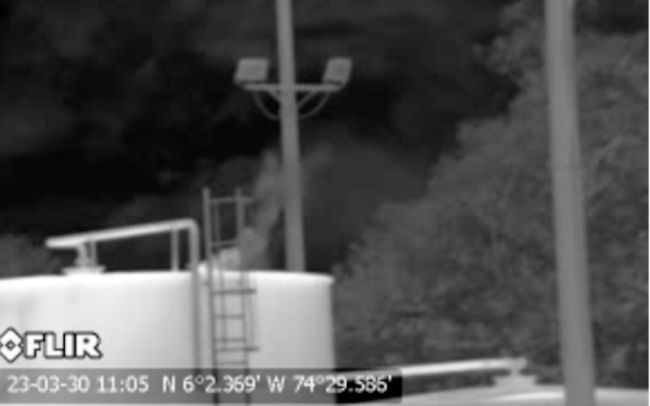
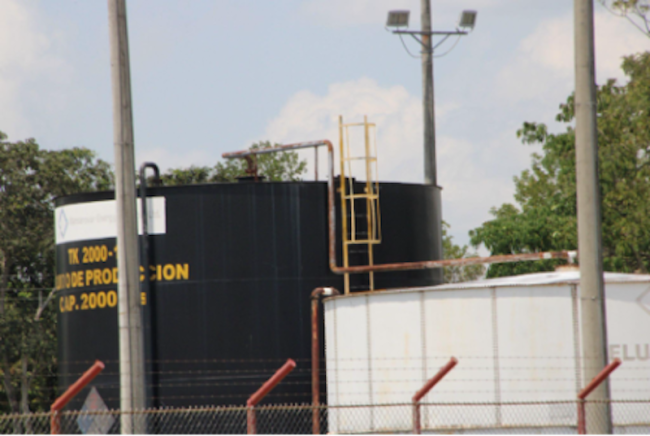
According to local residents—who agreed to be interviewed anonymously due to fear of reprisals—children commonly experience intense headaches and fainting, which they attribute to the close proximity of oil and gas facilities to schools, homes, and community centers. “It is not the tranquility that the people would like to have to enjoy a healthy environment,” one resident says while pointing to the marsh and surrounding trees nearby. Residents also reported having seen a few cases of cancer in children in recent years, particularly in nearby fishing communities. The strong smells—akin to rotten eggs—keep people awake at night. While residents won a form of constitutional human rights protection called a tutela in 2019 that ordered the companies to clean up the pollution, the courts have not enforced it. Community members say the industry’s words and actions have been contradictory. Companies announce the closing of problematic wells, but then other companies resume operations in their place. According to residents, relevant regulatory agencies like the National Agency for Environmental Permits (ANLA) often do not respond to residents’ repeated complaints about the smells and noise.
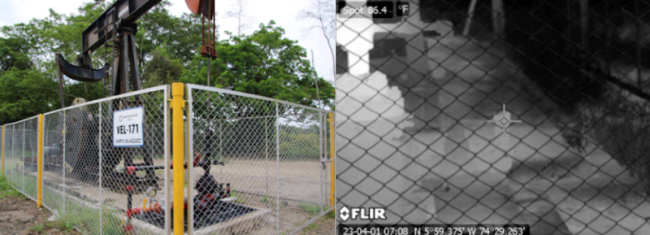
Driving southwest from Barrancabermeja, after crossing the Magdalena River into Shell’s former playground in Yondó and Casabe, Ecopetrol oil and gas wells dot the roadside every two minutes. At these wells, we found a similar degree of trouble with poorly combusting flares, venting, and fugitive emissions, particularly released near public spaces and roads.
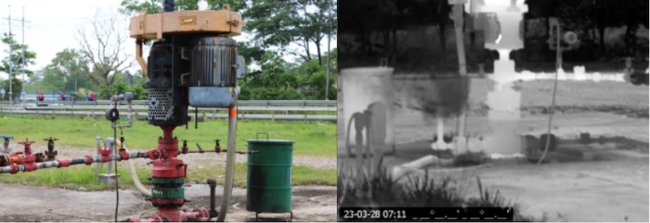
Failed Solutions
In February 2022, the administration of former President Iván Duque adopted best practices for regulating methane, like rules around leak detection and repair, monitoring, and the installation of vapor recovery units (VRUs) to capture gasses. The new rules, which came out of cooperation with international organizations like the Clean Air Task Force (CATF) and the UN Environment Program (UNEP), have been lauded as novel. The rules address both flaring and fugitive emissions in one single regulation (Resolution 40066 of the Ministry of Mines and Energy), which would seemingly help to diminish the uncertainty and gaps in regulatory requirements and also include third-party verification of flare efficiency.
Yet more than a year later, few, if any, of the sites we visited seemed to have vapor recovery units, and the seven apparent inefficient flares and numerous gas releases we captured with OGI could be interpreted as violating the adopted rules.
At a site we visited in Puerto Boyacá that had been shut down for many years, the abandoned well’s underground valve in the middle of a private pasture still contained a bubbling liquid releasing methane and volatile organic compounds. The broader Palágua oil field in which the abandoned well lies was discovered in 1954 by Texas Petroleum, and in 1986, the concession was reverted to Ecopetrol. Over the years, Ecopetrol has granted concessions in the field to domestic and foreign companies, including inside the private farm property we visited. Furthermore, Texas Petroleum’s dubious clean-up efforts have introduced invasive species that are now contributing to the drying of wetlands.
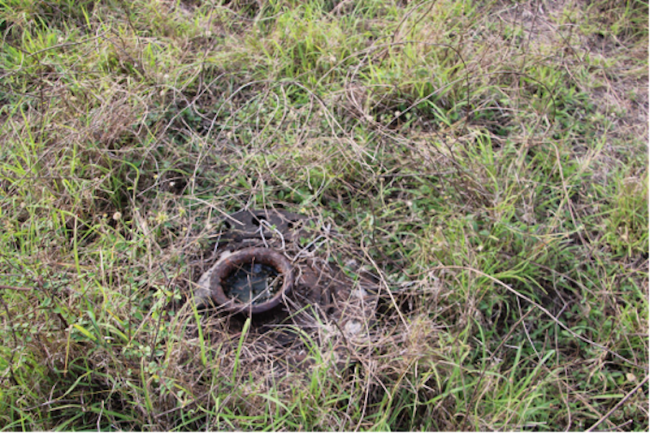
The contamination in this oil field is vast. The owner of a local pasture farm, whose name is being omitted for safety reasons, showed us at least eight oil and gas infrastructure sites inside their property, where we observed fugitive gas being released as well as extensive evidence of oil spills in a marsh.
Near an oil facility, mounds of oil-contaminated soil appeared ready to be spread near the marsh, but the purpose was unclear. “The remediation processes cannot continue to be done like they are being done now,” the property owner said. “It’s a vicious cycle: contamination, then remediation that creates more contamination.”
About 125 miles north of Puerto Boyacá is the big city of Barrancabermeja, home to Colombia’s largest refinery, operated by Ecopetrol. Standing alongside the Magdalena River, the refinery boasts dozens of processing plants, hundreds of storage tanks, and 4,500 direct and subcontracted employees. But it also has a history of labor conflicts and responsibility for health and environmental impacts. Furthermore, its location in the city center positions it at the intersection of conflicts between guerrilla, paramilitary, and narco-criminal groups that claim territorial control over vast areas of the city.
During our visit to the Barrancabermeja refinery in March 2023, the smell of petroleum all around the city was a testament to the power of Ecopetrol. Although the refinery has been in operation since 1922, it was only in 2012 that mobilizations by civil society won a battle for public air monitoring following a spike in respiratory diseases. But according to local leaders who wished to remain anonymous, authorities have not made the air quality data intelligible to non-experts, meaning communities have not been able to definitively link their health problems to the oil and gas industry.
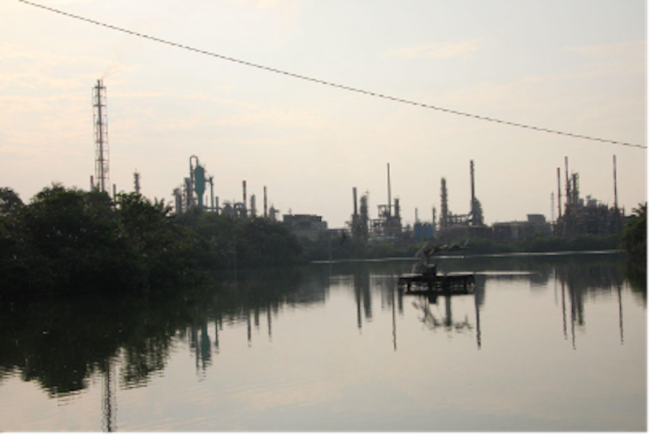
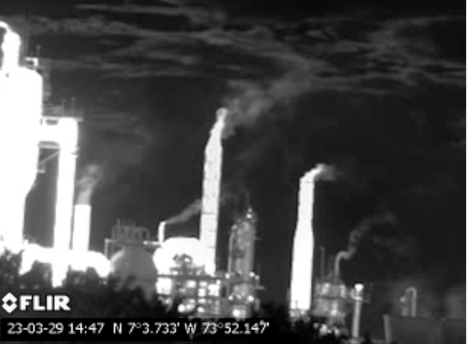
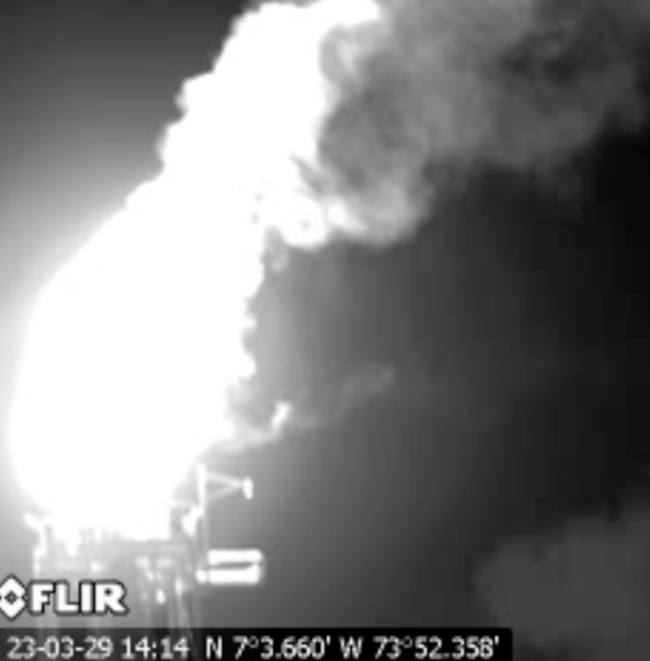
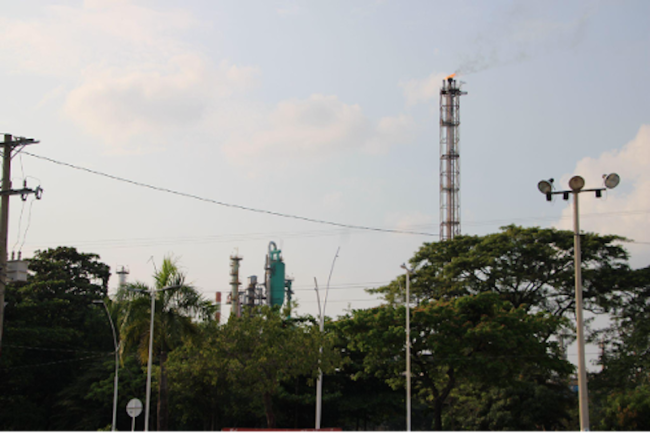
“We Live and Eat Petroleum”
Over the past three years, Ecopetrol has conducted a $780 million upgrade of the 100-year-old facilities to improve efficiency and reduce emissions. At the same time, it has announced a $64 million investment in strengthening its relationship with the city. But when asked whether the community is excited, local leaders are skeptical. “It is not easy to see such a future,” one said, “because the dominance of the hydrocarbon industry means we continue to live petroleum, to ‘eat’ petroleum, and the government doesn’t give us a direction.” The refinery is the city’s main economic driver, and most residents count on income from the industry, whether directly or indirectly through services such as catering and transportation.
As the Crude Lies report, Iguana papers, and Earthworks’ own investigation in Magdalena Medio collectively show, an entrenched system of wrongdoing, surveillance, and coercion in Colombia’s oil and gas sector will continue to impede efforts toward fairness, justice, and environmental sustainability for all Colombians. Ecopetrol, like oil and gas companies worldwide, must change its business model away from extraction and its adversarial stance towards local communities— barriers that obstruct a just and fair energy transition. Until then, investors should divest from the company.
Meanwhile, Petro’s administration has laid out ambitious plans to transition away from fossil fuels. My investigation in Colombia starkly exposed the deep challenges and contradictions behind this effort. For communities and the world, the possibility of a truly just transition hangs in the balance.
This is the first of two articles by Patricia Rodríguez on the challenges and prospects of a just energy transition in Colombia.
Patricia Rodríguez works as International OGI (Optical Gas Imaging) Analyst and Advocate at Earthworks. OGI is an infrared technology that detects fugitive and poorly combusted emissions of methane and volatile organic compounds from the gas and oil industry.

